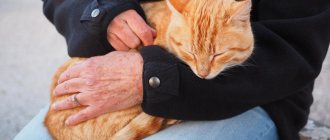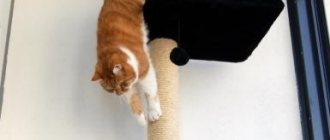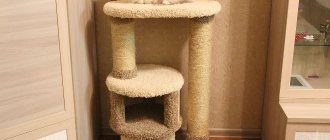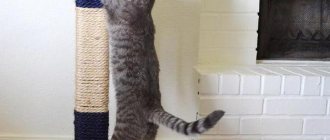A veterinary passport for a cat is its main document. It is issued immediately during a visit to the veterinarian with the first vaccinations. Then all information from vaccination, treatment against parasites and other information is entered into it. This article will tell you how to make a passport for a cat.
Veterinary passport of the cat.
What is a passport for a cat?
The animal's passport is transferred to the new owner along with the animal itself. All kittens over three months old should have it. At the moment, the international model is used everywhere in Russia. It contains certain information about a specific animal:
- his nickname;
- sex and age of the animal;
- breed;
- color;
- eye color;
- special appearance features;
- stamp number;
- laboratory test data (if carried out);
- information about vaccinations, including treatment against helminths.
Vaccination notes in the veterinary passport.
Sometimes information about surgical interventions performed (applies to the reproductive system) is included. The data of the cat's owner is also included in the passport. There are also additional columns required when changing ownership. Without this document, the animal cannot appear in any public place, including public transport, for example, when traveling from home to the veterinarian.
When vaccinating an animal, a sticker from the vaccine bottle is affixed to the passport. It indicates the name of the drug, its dosage, the validity period of the vaccine, and the serial number. The sticker must also bear the seal of the veterinarian who performed the procedure.
Veterinary passport
A cat passport is a document for identifying the animal. It contains all the information about the animal, its appearance, health and other important information. Absolutely all cats and dogs should have it, as it contains vaccination marks.
You will also definitely need it if you plan to travel by plane or train. To fly, the minimum requirement for an animal is a rabies vaccination. This requirement applies to domestic flights only. For international flights the requirements are much stricter.
An example of filling out a cat's veterinary passport.
International veterinary passport
If owners are going to leave the country with their pet, they will need to obtain an international veterinary passport for the cat. All entries are made in two languages – English and Russian. In addition, you must have all the necessary vaccination records on hand. They should be prepared in advance by reviewing the requirements for importing animals in a particular country.
Good to know: What is lichen in cats.
There is another form of passport for animals - a European passport. It is valid only in EU countries. All its fields are filled out in four languages, namely the following:
- Russian;
- English;
- German;
- French
There are no European passports in our country. Some breeders and nurseries make copies of them, but they are practically no different from the Russian model, and are much more expensive.
International veterinary passport.
Passport about the breed and pedigree
The birth certificate for a kitten is issued by the club where the cat is a member. Specialists from this club examine kittens to identify defects and establish whether they meet the requirements of the breed. This procedure is performed on the 45th day after birth. The document is essential for purebred animals.
It may not exist if the breeder provides the new owner of the kittens with an official pedigree. It contains basic information about the animal:
- pedigree number;
- nickname;
- gender of the animal;
- Date of Birth;
- color and breed;
- information about four generations of the kitten’s ancestors (titles, colors, breed).
- For the first three generations, pedigree registration numbers must be indicated.
Useful material: how to wash a cat correctly.
In addition, the breeder's phone number, last name, first name, and address must be indicated. The document is certified by the seal of the club. If a kitten is not purchased for further breeding and will be sterilized, a special note “not for breeding” is placed in the contract.
Sample cat pedigree
How to make documents for a cat from scratch if they are missing
An animal is not always purchased immediately with the entire package of certificates and certificates. Some breeders sell kittens without metrics and pedigree, but much cheaper than from the club. In this case, you are acquiring what appears to be a purebred animal, but this has not been confirmed by anything.
If during the process the owner decides to participate in breeding, they will need to try to obtain paperwork for the cat. It is better to immediately ask the breeder whether he has activated the litter in the club. If yes, then you need to take his patrimonial metric, on the basis of which you will then receive a pedigree.
If any documents for the cat are missing or are only partially available (pedigree of the mother, but no information about the father), it will be difficult to register the cat. Since there is no actual information about the pet’s ancestors, you can get a certificate from the club. Based on it, the initial pedigree is subsequently drawn up. It gives the right to experimental breeding.
With this certificate you can participate in exhibitions, mating even with titled cats. But even if mating has occurred with a titled animal, the offspring are still considered experimental.
There are two ways to obtain a breed certificate (and a pedigree based on it).
- Sign up for an examination at the club, where a specialist will determine whether the animal matches the breed characteristics (certification).
- Apply for participation in the exhibition of ordinary domestic cats. Before the show, the pet will be sent for an examination to determine whether it matches the breed.
You also need to be prepared for the fact that you will be denied a pedigree. The club can do this immediately, before the examination (this is due to the reluctance of the club itself). In this case, just contact another one. If the refusal was based on the results of an examination, the cat does not correspond to any breed characteristics.
A similar procedure is also suitable for those who are interested in how to find out the breed of a kitten and obtain documents for it. If he is taken from a shelter or picked up from the street.
Share link:
- Click to share on LinkedIn (Opens in new window)
- Click to share on Reddit (Opens in new window)
- Click to share on Pinterest (Opens in new window)
- Click to share on Telegram (Opens in new window)
- Click to share on WhatsApp (Opens in new window)
- Click to share on Skype (Opens in new window)
Where to buy a passport form
To make a veterinary passport for a cat, you need to purchase a blank form. This is a book with columns for entering data about your pet. This form is sold in veterinary stores and veterinary clinics and costs 100-200 rubles. The same form exists for dogs and cats.
How to take a photo of a cat
A photo of the animal is pasted into the passport to accurately identify the animal. There are no strict requirements. This must be a photo of the face of a pet older than one year. It should be of good quality, that is, clear, preferably against a contrasting background. For a white cat it is better to choose a dark one, and for dark animals, on the contrary, white or light.
You can take a photo at home, for example, on your phone, and paste a printed version of it into your passport form.
Chipping
Using the chip, you can accurately determine the owner of a cat or dog if the pet is lost. If for some reason the paper version of your passport is lost, it can be easily restored using the information from the chip.
Question to the expert
What is cat microchipping and why is it needed?
This is an electronic version of the passport, which is implanted into the body of the animal itself. With its help you can easily find out all the information about the cat and its owner. In some EU countries the procedure is mandatory for all pets. If the rule is not followed, the owner faces a fine. In Russia this process is just beginning.
The average cost of chipping is 600-1500 rubles. It is safe for the animal and is carried out in a veterinary clinic under the supervision of a specialist.
Microchipping a cat
What data should be indicated in the passport
The pet passport must contain the following information:
- About vaccination. Opposite each vaccination item should be recorded: the name of the drug (sticker from the ampoule);
- its serial number;
- date when vaccination was carried out;
- doctor's signature;
- clinic stamp.
- name of the drug used;
On the page about deworming, the date of the procedure, the name of the drug and its dosage must be indicated.
- name of the product;
- date of last mating, estrus;
- FULL NAME.;
In addition, genomic analysis (DNA) data is often indicated. Such information is extremely important for expensive purebred cats. If a pet is lost or stolen, having a chip is not enough to restore rights, since there is no single database of chipped animals. Therefore, if a cat is lost or stolen in another country, it may be difficult to prove anything. For this purpose, information from DNA analysis is needed.
What should be included in the description of the animal
The description of the animal on the corresponding page of the passport includes:
- Nickname. The pet's name is copied into the passport in accordance with the instructions in the pedigree. This applies to purebred animals. If the cat does not have a specific breed, then the nickname is entered at the discretion of the owner.
- Date of Birth. If the pet is purebred, then the data will be recorded in the metric or in the pedigree. If the owner has no idea when exactly his pet was born (mongrel, picked up on the street), the date can be written approximately.
- Gender: female or male. New passports contain the column “Castratus”. It must be filled out if the pet is sterilized.
- Breed. The data is exactly copied from the pedigree. If the cat is not purebred, then in the “Breed” column it is indicated: “Mestis”.
- Color. The color can be indicated as a name (word) or a code designation. The color of an outbred pet is indicated by simple adjectives, for example: “black”, “white”, “tri-color”, etc.
- Wool. There are 4 options to fill out this column. One of them must be entered: hairless;
- long-haired;
- short-haired;
- semi-longhaired.
Deadlines established for registration and re-registration of animals
The animal is registered at the veterinary clinic. If this is an adult animal, then no later than 1 month from the date of acquisition or appearance in the house. When it comes to kittens, the baby is registered upon reaching the age of 60–90 days.
Re-registration of an animal is carried out in the following cases:
- change of owner;
- moving to another region.
Registration and re-registration can only be completed by a doctor. An entire page is dedicated to this. The doctor’s signature must be present here, as well as the clinic’s stamp. The license number must be clearly visible.
Re-registration of an animal occurs in the event of a change of owner or relocation
How to fill it out correctly
The passport must be completed only by a veterinarian. He enters information into the appropriate columns and sections. If the kitten’s date of birth is not reliably known, approximate data is entered in the breed section, for outbred individuals, “mixed breed” is entered.
All entries are made in blue or black ink in clear, legible handwriting. Information about vaccinations and surgical operations is entered immediately after the procedures themselves. This section is also filled out exclusively by a clinic specialist.
Why do you need a veterinary passport for a cat?
Firstly, it indicates medical data, but, in addition, it is required for purebred kittens. Pets with pedigrees without a document will not be able to participate in exhibitions, they will not be transported on trains, planes, or taken abroad.
Provided that the cat is not purebred, a passport will not hurt in any case. In it, the veterinarian will note the scheduled vaccination to comply with the schedule so as not to miss the date of the next vaccination.
The entries in the document help to identify in emergency situations whether treatment for worms and ticks has been carried out, and whether the cat has been vaccinated against rabies. Information received in time will give an advantage in treatment.
Cat owner details
A veterinary passport for a cat contains brief information about the owner of this animal. The following information must be entered:
- Full Name;
- residential address;
- telephone.
Additionally, an email or phone number can be entered. If they have changed, they must be corrected to be current.
Material on the topic: how to stop a cat from shitting.
Additional marks
Additional data includes changes in information about the owner of the animal, as well as what surgical operations were performed on the pet. If there is any striking sign (different eye colors, a scar, a mark from an injury, an unusual spot of coat color) - this should also be mentioned.
How much does it cost to get a passport for a cat?
At the moment, the average cost ranges from 500 to 2500 rubles, depending on the veterinary clinic where this action is carried out. A blank form costs about 100-200 rubles. Some clinics issue a document for free, as a gift for the first examination and vaccination of the animal.
Useful article: how to clean a cat's ears.
Document appearance
In Russia, a veterinary passport for a cat does not have one set form and can be different. The basis here is not the appearance, but its internal content. However, there is an exception in certain regions of the country. For example, in St. Petersburg, strict veterinary rules have been established. The passport you can make there will look exactly like this:
Keep in mind that it will be difficult to get abroad with this document, since there is no place for a photograph of the pet, and the columns are printed only in Russian and English. This is a very serious reason to refuse your travel abroad.
Before you get a passport for your cat, thoroughly study all the rules for exporting an animal, as well as the region in which you will be drawing up the document.











